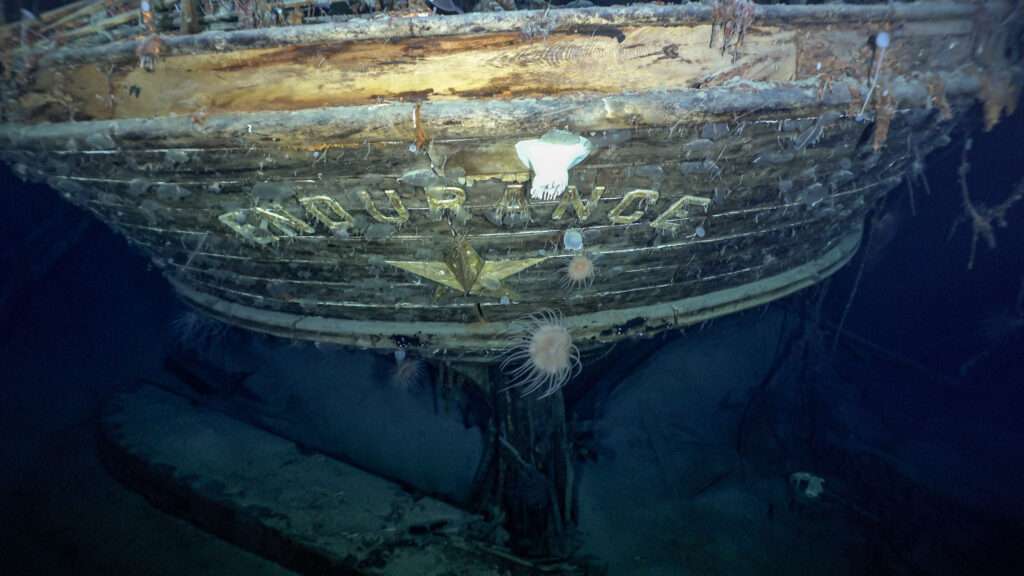
A team of researchers has found the wreck of Endurance, a ship that sank off the coast of Antarctica more than 100 years ago.
The captain of Endurance was the British polar explorer Sir Ernest Shackleton. The ship sank after becoming trapped in ice on its way to Antarctica in 1915.
The researchers’ mission is called Endurance22. They set sail from South Africa in February, headed for the last known location of Endurance that was recorded by its captain before it sank.
They used helicopters and underwater robots to search for the ship.
On March 9, the researchers announced they had found Endurance. It was about six kilometres south of where it had sunk.
The old wooden sailing ship was three kilometers down, at the bottom of the Weddell Sea which is located at the north part of Antarctica. Endurance has been very well preserved because the water is so cold no wood-eating organisms live there.
The shipwreck is considered an historic monument. Because of that, the researchers will not touch it or take anything from it. They studied it from a distance, using cameras on underwater robots. Their photographer is Esther Horvath.
Endurance’s Voyage, 1914-15
In December 1914, Endurance set sail from an island called South Georgia in the South Atlantic Ocean. It was carrying 28 men on an expedition led by Shackleton. They planned to cross Antarctica on foot, from the Weddell Sea on one side, overland to the South Pole and then on to the Ross Sea on the other side of the continent.
By January 1915, Endurance had become frozen in the ice in the Weddell Sea. Shackleton and his men lived on the ship for months, with no way to summon help from the outside world. Eventually, the pressure of the ice crushed the ship’s hull. The men moved all of their provisions and equipment—including three lifeboats—onto the ice. On Nov. 21, 1915, Endurance sank.
The men lived on the ice until April 1916, when it began to break up. The men took what they could in the lifeboats and rowed for five days until they reached Elephant Island, 557 kilometres from where Endurance sank.
Shackleton knew no ships would find them there, so he and five crew members set out in one of the lifeboats. They travelled 1,300 kilometres in 16 days, finally landing on South Georgia. On May 20, after crossing the island on foot, they found a whaling station where they could get help.
Because of heavy sea ice, it took four attempts to get back to Elephant Island but on Aug. 30, 1916, all of Shackleton’s remaining crew were rescued.
The leader of Endurance22, which found the ship, was John Shears, a polar geographer from the UK. The director of exploration for the recovery expedition is Mensun Bound and the ship’s captain is Knowledge Bengu.
THINK & DISCUSS QUESTIONS
- Ernest Shackleton was an explorer during a time known as the Heroic Age of Antarctic Exploration. Why was it known as “Heroic”? What other explorations took place during that period?
2. Often when we learn about famous explorers like Shackleton, the people who were living in the “explored territory” at the time are not mentioned, almost as if they didn’t exist (or get there first!). Instead, history typically refers to the explorers, who were often from Europe, finding out about a place that was already occupied. Is that the case here? Why or why not?
3. What interesting facts can you find out about Antarctica? For instance, how many people live there today? How big is it? What animals can be found there? What language is mostly spoken there? Does Antarctica have Wifi? A McDonald’s restaurant? Volcanoes? Which way is north from Antarctica?
4. There are a lot of dates mentioned in this article. Create a timeline plotting the dates from the expedition until the discovery. If you can, find out more facts about both and add them to your timeline.
5. Similarly, see if you can locate the places mentioned in the article on a map. Draw the route of Endurance (see below for a link to a BBC article which includes a map of Endurance’s route).
6. Lots of facts have been left out of this article, including about Endurance22 as well as other, unsuccessful, attempts to find the ship. What questions do you have about this event? How can you find out the answers (and make sure the information you’re finding is accurate)?
7. The article mentions only the men involved in Endurance’s 1914-15 voyage. Why do you think that is?
8. What does the word “endurance” mean? Do you think it is a fitting name for the ship? Why or why not?
9. Say “Antarctica” five times fast. Ha! It’s a tricky word to say, isn’t it?
LINKS TO MORE INFORMATION
Discovery of Endurance https://www.youtube.com/watch?v=H6kztLDU0xU
Information about the Endurance22 expedition https://endurance22.org/
Lots of great images of the mission, taken by Endurance22 expedition photographer Esther Horvath: https://endurance22.org/endurance22-news/endurance22-gallery
National Geographic documentary about Ernest Shackleton https://www.youtube.com/watch?v=sgh_77TtX5I
Ten super-interesting facts about Antarctica, written by Nina Gallo, a certified polar guide and author of the book “Antarctica”: https://www.aurora-expeditions.com/blog/10-fun-facts-about-antarctica/
More photographs and a 90-second video of Endurance, as well as other expedition images here: https://collect.wetransfer.com/board/sowc348bfrvti58ge20220307165300
Wonderful BBC article about Endurance22’s discovery—it includes an excellent map with the route of Endurance as well as links to articles about other missions to find Endurance: https://www.bbc.com/news/science-environment-60662541







